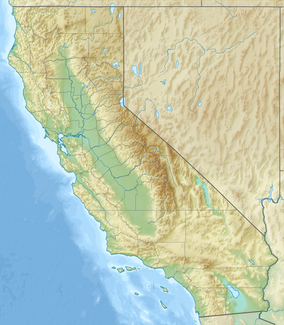Calaveras Big Trees State Park
| Calaveras Big Trees State Park | |
|---|---|
| 284px
Hikers at the foot of a giant sequoia
|
|
| Location | Calaveras and Tuolumne Counties, California, USA |
| Nearest city | Arnold, California |
| Coordinates | Lua error in package.lua at line 80: module 'strict' not found. |
| Area | 6,498 acres (2,630 ha) |
| Established | 1931 |
| Governing body | California Department of Parks and Recreation |
Calaveras Big Trees State Park is a state park of California, USA, preserving two groves of giant sequoia trees. It is located 4 miles (6.4 km) northeast of Arnold, California in the middle elevations of the Sierra Nevada. It has been a major tourist attraction since 1852, when the existence of the trees was first widely reported, and is considered the longest continuously operated tourist facility in California. The area was declared a state park in 1931 and now encompasses 6,498 acres (2,630 ha) in Calaveras and Tuolumne Counties.[1]
Over the years other parcels of mixed conifer forests, including the much larger South Calaveras Grove of Giant Sequoias (purchased in 1954 for $2.8 million USD), have been added to the park to bring the total area to about 26 square kilometres (6,400 acres). The North Grove contains about 100 mature giant sequoias; the South Grove, about 1,000.
The North Grove included the 'Discovery Tree' noted by Augustus T. Dowd in 1852 and felled in 1853, leaving a giant stump which is the only remainder of the tree. It measured 24 feet (7.3 m) in diameter at its base and was determined by ring count to be 1,244 years old when felled. However, the largest tree was believed to be the Mother of the Forest, which died after bark was stripped from it in 1854. Today only a fire-blackened snag remains.
In addition to the popular North Grove, the park also now includes the South Grove, with a 5-mile (8.0 km) hiking trip through a grove of giant sequoias in their natural setting. The South Grove includes the Louis Agassiz tree, 250 feet (76 m) tall and 25 feet (7.6 m) in diameter 6 feet (1.8 m) above ground, the largest tree in the Calaveras groves.[2] It is named after zoologist Louis Agassiz (1807–1873).
Other attractions in the Park include the Stanislaus River, Beaver Creek, the Lava Bluff Trail and Bradley Trail.
The park also houses two main campgrounds with a total of 129 campsites, six picnic areas and hundreds of miles of established trails.
Other activities include cross-country skiing, evening ranger talks, numerous interpretive programs, environmental educational programs, junior ranger programs, hiking, mountain biking, bird watching and summer school activities for school children. Dogs are welcome in the park on leash in developed areas like picnic sites, campgrounds, roads and fire roads (dirt). Dogs are not allowed on the designated trails, nor in the woods in general.
-
Discovery Tree stump and part of the fallen tree
-
Discovery Tree stump, shortly after its discovery
-
GiantStumpCalaverasNorthGrove.jpg
Discovery Tree stump
-
CalaverasBigTrees2.jpg
Human compared to tree height
-
CalaverasTreeTunnel1.jpg
Tunnel in the Pioneer Cabin Tree, cut in the 1880s to compete for attention with Yosemite's Wawona Tree
-
Calaveras tree.jpg
A tree in the North Grove that was harmed by human activity and burned in the 1908 fire
See also
- List of sequoia groves
- List of California state parks
- Mother of the Forest
- Calaveras Big Tree National Forest
References
External links
| Wikimedia Commons has media related to [[commons:Lua error in Module:WikidataIB at line 506: attempt to index field 'wikibase' (a nil value).|Lua error in Module:WikidataIB at line 506: attempt to index field 'wikibase' (a nil value).]]. |
- Pages using duplicate arguments in template calls
- Pages with broken file links
- Commons category link from Wikidata
- State parks of California
- Campgrounds in California
- Forests of California
- Giant sequoia groves
- Parks in Calaveras County, California
- Parks in Tuolumne County, California
- Protected areas established in 1931
- Protected areas of the Sierra Nevada (U.S.)
- 1931 establishments in California


